Not a portrait of Franz Schubert
Posted by Richard on UTC 2019-05-23 08:21 Updated on UTC 2019-05-28
First things first
This here is not a pipe. It is a digital representation of an illustration of a pipe.
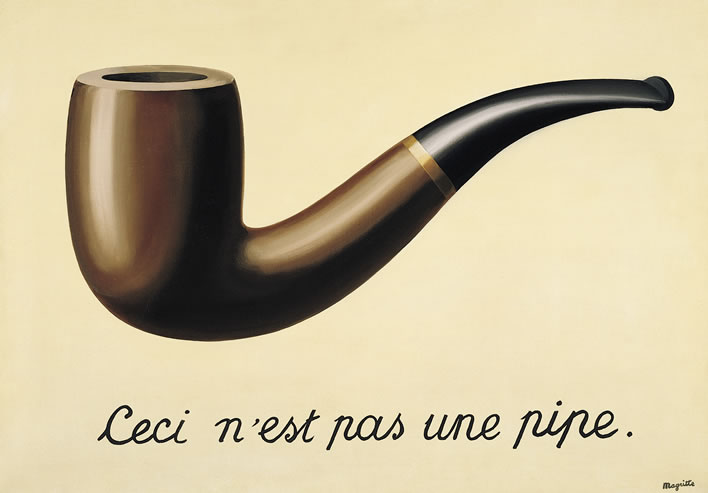
Rene Magritte (1898-1967), The Treachery of Images (This is Not a Pipe), La trahison des images (Ceci n'est pas une pipe), (1929) Source: Los Angeles County Museum of Art (LACMA)
This here is not Franz Schubert. It is not even a digital representation of an illustration of Franz Schubert. The figure is not Franz Schubert, nor is it his image.
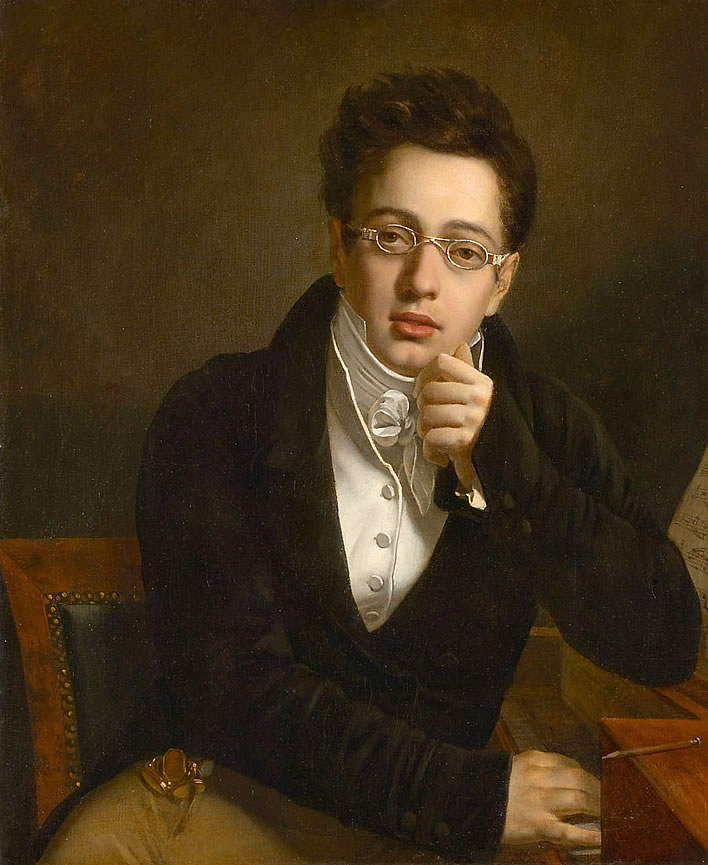
Der junge Schubert, 'The Young Schubert', Kunsthistorisches Museum Wien, Neue Burg, Sammlung alter Musikinstrumente Saal 15. Image: online.
This here is a digital image of a photograph of a life/death mask of Franz Schubert. It was either cast shortly after his death on 19 November 1828 or at some unknown time during his life. It is the most accurate representation we have of the appearance of the composer.
If we can speak of authenticity in this context then this conveys to us an authentic impression of Schubert's face – it is as though we were looking at him. This is Franz Schubert.
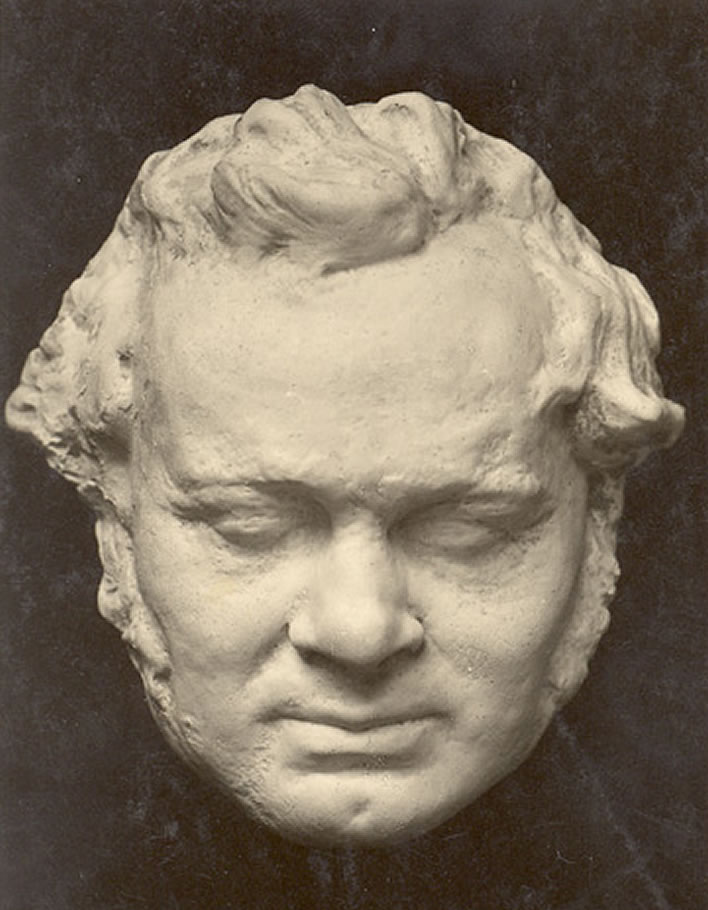
Delusion
For some baffling reason, a particular mass hysteria has spread through the Schubert world during the last twenty-five years. Traces of it are found on the covers of books about Schubert, on the covers of CDs of his music and in any article concerning him. Its main symptom is the delusion that the painting shown above – unknown date, unknown artist, unknown sitter and unknown distant provenance – is a portrait of the 'young Schubert'.
Even the current home of the painting, the Kunsthistorisches Museum Wien, Sammlung alter Musikinstrumente, which really should know better, reveals that it, too, has fallen for the delusion:
The young Schubert
The present oil painting is neither signed nor dated. Recent investigations of the stylistic characteristics of Schubert's facial form supported by measurement analyses indicated with a probability bordering on certainty that it is a picture of the young Franz Schubert. The portrait shows a young man in a thoughtful pose, in which the main axis of the body is tilted at an angle to the vertical. The position of the arm and the head can be seen as a visualisation of the thought process. The sketchy representation of a square piano suggests a musician; a music score and a pencil show him to be a composer. Unfortunately the suggested name on the keyboard cover of the instrument as well as the music score on the holder are not readable. The ornament on the right hip of the young artist can be seen as a fashionable attribute such as a watch charm or a signet bundle.
Der junge Schubert
Das vorliegende Ölgemälde ist weder signiert noch datiert. Jüngste Untersuchungen der stilistischen Merkmale und auf Schuberts Gesichtsform gestützte Maßanalysen ergaben mit an Sicherheit grenzender Wahrscheinlichkeit, dass es sich um ein Bildnis des jungen Franz Schubert handelt. Das Portrait zeigt einen jungen Mann in nachdenklicher Pose, wobei die Hauptachse des Körpers schräg angelegt ist. Arm- und Kopfhaltung sind als Visualisierung des Denkprozesses anzusehen. Das in Ansätzen erkennbare Tafelklavier deutet auf ihn als Musiker hin, Notenpapier und Bleistift erweisen ihn als Komponisten. Leider ist die angedeutete Signatur auf dem Vorsatzbrett des Instruments ebenso wie die Noten auf dem Pult nicht lesbar. Als modisches Attribut sind die Schmuckstücke an der rechten Hüfte des jungen Künstlers anzusehen, eine wohl an der Uhrkette angebrachte Berlocke oder ein Petschaft.
[Derzeit ausgestellt: Neue Burg, Sammlung alter Musikinstrumente Saal 15, Kunsthistorisches Museum Wien, Sammlung alter Musikinstrumente, online.]
The Kunsthistorisches Museum Wien goes on to assert that the portrait was painted by Josef Abel (1764 Aschach/Oberösterreich-1818 Wien). Strangely, the question mark they forgot to put after Abel's name seems to have slipped behind the rubric Kultur, where a painting depicting with 'near certainty' a known Viennese composer painted by known Austrian artist gets a touchingly hesitant Österreich (?).
The hobby horse
Rita Steblin, among her many major firsts in Schubert scholarship, was the first to document the journey of this painting from its beginnings in obscurity to its modern renown. [Steblin_1 passim]
The portrait first surfaced in Paris on the stand of the Parisian antiques dealer Marguerite Semail (Meubles - Objets d'art - Gouaches - XVIIe et XVIIIe siècles, début XIXe) at the sixth Antiques Biennale at the Grand Palais in September 1972. It was bought by Parmenia Migel Ekstrom (1908-1989), a ballet historian, writer, founder and president of the Stravinsky-Diaghilev Foundation and a fervent collector.
According to Albi Rosenthal (1914-2004):
As I already mentioned, the painting was purchased by Mrs Parmenia Ekstrom about twenty years ago in an art dealers in Paris (as an anonymous French portrait of an unknown man). She got it into her head that it could be a portrait of Schubert (about whom, however, she knew very little). At the time, I sent a photograph to Vienna – with my apologies in advance – and received the expected answer, that this was not a portrait of Schubert.
Wie ich Ihnen bereits erzählte, wurde das Bild von Frau Parmenia Ekstrom vor etwa 20 Jahren in einer Bilderhandlung in Paris (als anonymes französisches Porträt eines Unbekannten) erworben. Sie kam auf die Idee, daß es Schubert sein könnte (von dem sie allerdings sehr wenig wußte). Ich schickte damals eine Abbildung nach Wien - mit der Bitte um Entschuldigung im voraus - und bekam die erwartete Antwort, daß dies kein Porträt von Schubert sei. [Rosenthal 91]
Steblin tells us that in 1973, in pursuit of Parmenia Ekstrom's hobby horse about the 'Schubert' portrait, the Ekstroms (her husband was an art dealer) wrote to Marguerite Semail for more information, but by this time Semail had died and the response came with a very Gallic shrug of the shoulders that none of her relatives could give any further information about this painting.
You buy a used deux chevaux as is, rust and all – so don't come back a year later asking questions about its provenance, zut alors!
Hmmm… What to do? Here we have the provenance-free painting of an unknown sitter by an unknown artist bought from a now dead antique dealer for the price of a modest snack at the Brasserie Lipp in the boulevard Saint-Germain. But if the sitter were indeed Franz Schubert and the painter were indeed Josef Abel then a lifetime of major snacks from the top restaurants of Paris lay ahead.
That charming rustbucket deux chevaux with the missing gearknob might just turn into a DS23 goddess overnight.
All it needs now is for a big name to assert that the portrait is indeed that of Schubert, that the deux chevaux is really a DS23 and the naked emperor is actually looking sharp in a natty Armani suit. Which is exactly what happened.
The big name was Yehudi Menuhin (1916-1999), no less, aided and abetted by the television producer Curtis W. Davis (1928-1986). Menuhin and Davis had produced an eight-part television series entitled The Music of Man for the Canadian Broadcasting Corporation. In the eponymous follow-up book to the series which appeared in 1979 the undated portrait of an unknown subject by an unknown artist was reproduced with a brazen attribution of the sitter:
Never previously published, this anonymous portrait of Franz Schubert was probably painted around 1816 when the nineteen-year-old composer's Ländler and other dances were at their most popular.
Quoted in [Steblin_1 12]
Menuhin and Davis seem to be thinking of the scene in that most Austrian of films, The Sound of Music (1965), in which Maria and Captain von Trapp hit it off whilst dancing 'the' Ländler, to a variation of the theme introduced in the 'Lonely Goatherd' puppet show scene. The Schubert fans among our readers, reeling from this insight into the life of their loved one, may be disposed to take the completely unfounded attribution as equally bogus.
Finding Schubert
The obscure wheels within wheels of the New York cultural elite – the Ekstroms, Menuhin, Davis and heaven knows who else – had rotated as designed and Parmenia's rusting, anonymous deux chevaux was on its way to becoming a thing of value. Now it was only necessary to wait a while.
Images of the painting with its Menuhin/Davis attribution came into circulation and began appearing as a 'portrait of Franz Schubert'. Parmenia died in 1989 (husband Arne kept going until 1996).
Around 1990 the undated portrait of an unknown sitter by an unknown artist – for that is what it still was – was offered for sale and bought in 1991 by the Kunsthistorisches Museum Wien, Sammlung alter Musikinstrumente, after some nudging by Ernst Hilmar's (1938-2016) International Franz Schubert Institute – the wheels within wheels of the Viennese cultural elite doing what they do best: spending public money and hamstering collectables. Although the price paid is unknown to your author, we are clearly well beyond the price of a small choucroute and a glass of house Riesling at the Brasserie Lipp. Job done.
In 1992 Rita Steblin, under the aegis of the International Franz Schubert Institute and the new owners of the painting, the Kunsthistorisches Museum Wien undertook a careful and extremely extensive examination of the painting and the documentary records surrounding it. Steblin's 42 pages of scholarly thoroughness led to a very brave and very conditional conclusion:
Since the portrait is unsigned, the identity [of the subject] will probably never be able to be completely clarified. If the sitter were not Schubert however, who then was the double with the same characteristics – such as spectacles wearer, asymmetric eyes, chin dimple, at the same time pianist and in particular composer – who found the same level of public notice in order to be portrayed in this form?
Da das „PORTRAT“ unbezeichnet und nicht signiert ist, wird die Identität möglicherweise nie ganz einwandfrei geklärt werden können. Sollte aber Schubert nicht der Dargestellte sein – wer war dann sein Doppelgänger mit denselben Merkmalen wie Brillenträger, asymmetrische Augenstellung, Grübchen im Kinn, gleichfalls Pianist und insbesondere Komponist —, der ebensolche Aufmerksamkeit finden mußte, um in der Weise porträtiert zu werden? [Steblin_1 46]
The conclusion was brave because it was reached in the face of what appears to have been powerful forces in favour of the attribution of the painting as a portrait of Schubert. Ernst Hilmar's foreword to Steblin's study is a masterpiece of rhetorical suggestion, which concentrates on mocking those who believe that the painting cannot be a portrait of Schubert by quoting various anonymised, generally silly statements from disbelievers.
Abracadabra
Hmm… What the gang needs is some real proof, some scientific proof, and for that we have Elmar Worgull (1949-), artist and art historian. In 1994, two years after Steblin's paper, he published in Hilmar's journal Schubert durch die Brille an isoproportionale Analyse, 'isoproportional analysis' (?) of the portrait.
Worgull was unhappy with Steblin's diffidence in the matter of attribution, an unhappiness he expressed in his characteristic academese:
On the other hand, the use of the conditional relativises the written down statements in such a manner that they are dominated by the character of the hypothetical and conclusions inevitably end with question marks.
Andererseits relativiert der Konjunktiv die niedergeschriebenen Aussagen derart, daß sie der Charakter des Hypothetischen dominiert und Schlußfolgerungen zwangsläufig mit Fragezeichen enden. [Worgull 55f]
In other words doubts, hesitancy and uncertainty are bad things – if you want to dispel them, Worgull is your man.
If you read German (ponderous, Beamtendeutsch German at that) and you have time on your hands and find this matter endlessly fascinating then you can read Worgull's paper. For those sensible people who have better things to do here is a paragraph précis, followed by some quoted conclusions.
Worgull finds Steblin's work overcautious [Worgull 55f]; gets the paint dated to between 1800 and 1830 [Worgull 56]; calls the spectacles in the painting 'historically proven' [Worgull 57]; the painting shows a young musician, the presence of a pencil indicates that he must be a composer [Worgull 58]; there are no authentic comparative comments on his portraits [Worgull 60]; Worgull reviews the existing portraits of Schubert and finds them largely concordant [Worgull 63]; the imponderables of this analysis are reduced by the analysis of Schubert's mask and skull [Worgull 63]; the portraits of Schubert are all 'true to life' [Worgull 63]; there is an 'isoproportional' agreement between mask and skull [Worgull 64]; by a comparison of the mask and the full-face portraits all differences can be resolved by 'modified isoproportional preconditions' [Worgull 64]; 'mouth, base of nose with nasal apertures, length of nose to to the bridge, eyes and in particular Schubert's right eyebrow display a maximum of agreement, also for the position of the temples, the hairline and the ears' [Worgull 65].
I could have added question marks and even exclamation marks after each of these statements. I have no idea, for example, what this 'isoproportional analysis' is. Worgull appends some photos and sketches and doodles, but calling it a 'mathematical proof' or even 'scientific proof' as some have done is akin to taking astrology as a science and the ouija board as an analytical tool.
Although he rejected the speculation that the artist had been Josef Abel, he accepted that the portrait was indeed that of the young Schubert: for him, based on his 'isoproportional analysis' there could be no doubt – so refreshing and so necessary after Steblin's scholarly caution!
Here he is, lumbering in inflated, academic German towards certainty, step by step [your author apologises in advance for inflicting these literal translations on you, but if he has to suffer, so must you]:
Summing up, we can state that the results so far represent a debatable precondition in order to risk the proposition: that the PORTRAIT contains essential, for Schubert characteristic dimensions in the face and head area, so that the image of the young Schubert can be seen in it.
Zusammenfassend ist festzuhalten, daß die bisher gewonnenen Ergebnisse eine diskutable Voraussetzung darstellen, um die These zu wagen: das „PORTRÄT“ beinhaltet wesentliche, für Schubert charakteristische Maße im Gesichts- und Kopfbereich, so daß darin das Bildnis des jungen Schubert gesehen werden kann. [Worgull 65]
Finally, the overall consideration of these facts, including the results from the comparison between PORTRAIT and mask, and mask and skull permits one to state that in the PORTRAIT of Schubert, authenticity can be proved with a probability bordering on absolute certainty.
Schließlich läßt die gesamtheitliche Würdigung dieser Fakten, einschließlich der Ergebnisse aus dem Vergleich zwischen „PORTRÄT“ und Maske und Maske und Schädel die Aussage zu, daß in dem „PORTRÄT“ Schuberts Authentizität mit an Absolutheit grenzender Wahrscheinlichkeit nachgewiesen sein dürfte. [Worgull 66]
In accordance with stylistic and art historical viewpoints there are no serious objections to the proposed dating [1814]. The consultation of paint-technical facts does not exclude a creation in 1814. As a result of these preconditions the conclusion is permissible, that, after all the single factors so far considered and their conditional agreement, this painting could represent the earliest authentic representative image of the young Schubert.
Nach stilistischen und kunsthistorischen Gesichtspunkten gibt es keine gravierenden Einwände gegen diese vorgeschlagene Datierung. Die Befragung der maltechnischen Fakten schließt die Entstehung um 1814 nicht aus. Unter diesen Voraussetzungen ist die Folgerung zulässig, daß, nach allen bisher betrachteten Einzelfakten und deren bedingten Übereinstimmungen, dieses Gemälde das früheste authentische Repräsentation-Bildnis des jungen Schubert darstellen könnte. [Worgull 72]
In the attribution of the painting Steblin assumes that the sitter is Schubert. This can in the context of the isoproportional investigations now be taken to be certain.
Bei der Zuschreibung des Gemäldes geht Steblin davon aus, daß der Dargestellte Schubert sei. Dieses kann im Rahmen der isoproportionalen Untersuchungen nunmehr als gesichert gelten. [Worgull 73]
Worgull did what was needed. His mathematical certainties were published in Hilmar's journal Schubert durch die Brille in 1994 (with Albi Rosenthal's brief letter appended), he was made an editor on Hilmar's Schubert-Lexikon (1997) and given a lecture at an international Schubert conference in 1997.
After emerging from the slithery pond of Worgull's lumbering 'proof' onto dry land, let us shake ourselves like wet labradors and attempt a return to the solid ground of sanity.
The Emperor has no clothes, commonsense edition
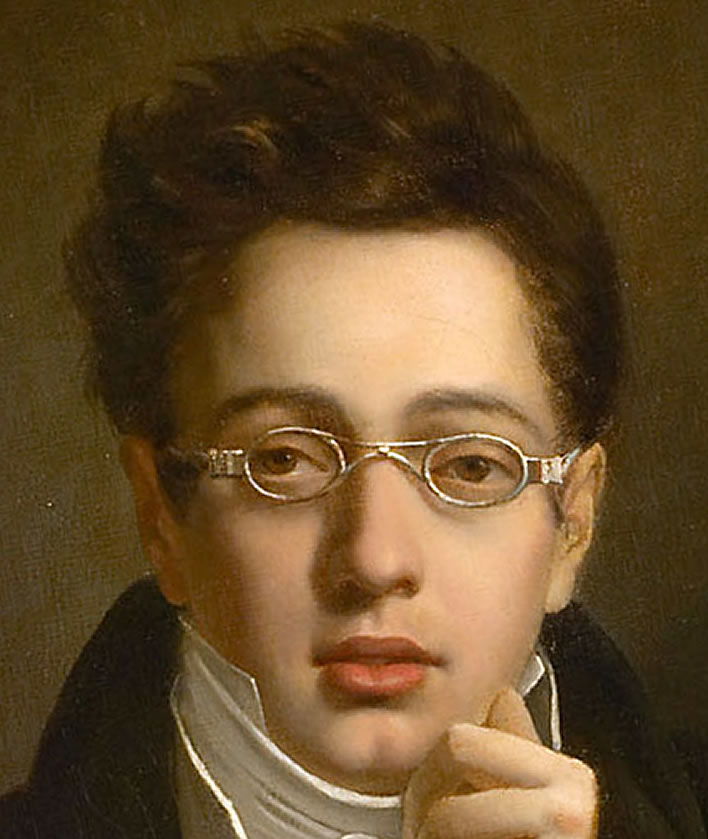
Now those who look at this image and feel the telltale flush that indicates the first rush of blood to the head manifested by an incipient attack of Young Schubert Derangement Syndrome (YSDS) should drink something soothing and cast alternating glances on the head of the sitter in the portrait and on Schubert's death mask, reproduced again here for your convenience:

Our question: under what circumstances, what pattern of life, can the features of the putative seventeen year-old sitter in the painting turn into the features of the thirty-one year-old composer whom we see in the mask?
Let me assist in answering this question with the following images. As you proceed through the illustrations you only need to keep asking yourself one thing: can the same person have both these features?
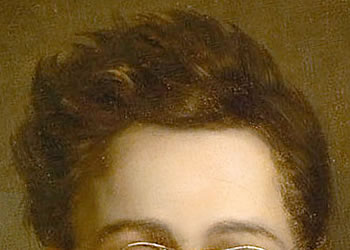
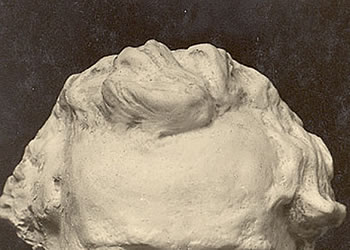
Franz Schubert's hair was renowned among his contemporaries for its natural curls. The hair of the sitter in the painting is completely different – not the hint of a curl.
Worgull, in order to explain this disparity, rests his entire case on another undated profile drawing of an unknown figure by an unknown artist (the attribution is usually 'Schober?') to prove that Schubert had different hairstyles during his life, or, perhaps, that his straight hair turned curly as he grew older [Worgull 68].
We are approaching the demarcation line of insanity.
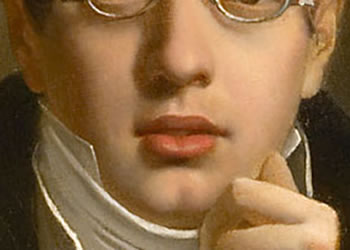
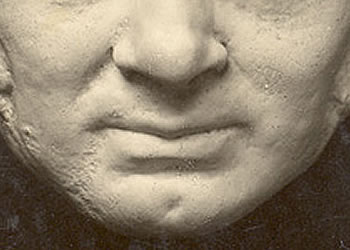
After hair which miraculously goes curly in the space of fourteen years, we now have the case of a long, narrow nose which grows short and broad during the same period.
Amazing, too, how narrow, pouting, selfie lips with pronounced upper and lower bows can evolve into broad lips with a narrow top lip and a straight-edged lower lip.
And even more so that the pronounced chin dimple of the mask seems to have started life off as a rather vague cleft in the chin.
One would think that a portrait artist worth his salt would get that defining feature right as a minimum, a feature so pronounced that it survived the mask-making process and is a characteristic shared with Schubert's father and all his male siblings.
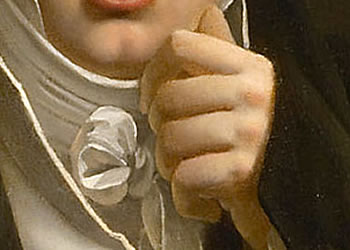
There are a number of occasions in the documentary record when those who knew Schubert remarked on his short, stubby, perhaps even pudgy fingers (not surprising in a corpulent person who was only just over five feet tall). The fingers of the sitter in the painting could not be described as stubby, but match the generally etiolated appearance of the body as a whole.
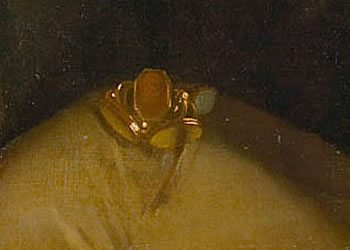
That Schubert would affect such modish fripperies as a signet bundle or a watch charm goes against everything we know about him. When he was seventeen he was so broke that he was scratching around to buy pre-scored paper for his compositions. It is difficult to imagine the desperately shy and introverted Schubert ever wearing such things.
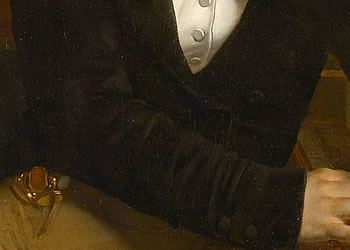
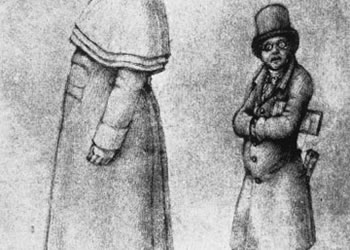
Can anyone really believe that the slim, etiolated body of the subject is that of Franz Schubert, whose pot belly was so cruelly caricatured by his 'best friend' Schober in an undated drawing.
We should also recall that passage in Bauernfeld's witty letter to Schubert, then in Steyr with Vogl, dated 13 September 1825:
How are things with you, closest/fattest friend? I think your belly will have increased; may God preserve it and let it flourish!
Wie geht's Dir, dickster Freund? Ich denke, Dein Bauch wird zugenommen haben; Gott erhalte ihn, u. lasse ihn gedeihen! [Dok 316]
Unfortunately, such commonsense objections to the identification of the subject of the portrait as Schubert have never been considered. Instead a number of silly suggestions were attacked by Hilmar and Steblin, avoiding the need to consider the objections in any serious way.
The belief that the painting is a portrait of the composer as a young man is deeply entrenched, cited as it now is as absolutely validated truth by so many authorities. Well, for those who still cannot free themselves from this delusion, here comes a numerical analysis. If visual comparisons do not persuade you, some cold numbers might.
The Emperor has no clothes, analytic edition
As we said at the beginning of this piece, the only image of Schubert that can be considered to correspond directly to reality is the life/death mask. If we are going to take this as the basis of our understanding of Schubert's physiognomy, we have to treat it with due caution. In other words, how far can we rely on the accuracy of the mask image of Schubert?
Neither portrait painters nor mask makers work to millimetre accuracy, meaning that we must not demand such precision from these two objects. As far as the painting is concerned, we have to assume that the aspect ratio of the image offered by the gallery has not been changed.
The integrity of the mask
The mask, however, is particularly vulnerable to distortions: the masks we have are copies of copies; as three-dimensional objects their two-dimensional representation in photographs can be affected considerably by lens characteristics; the quality of the photographs available is very poor and we have no guarantee that their aspect ratios have been preserved. We can at least carry out a simple sanity check on the photographs we have of the mask. If all three of them are reasonably concordant we can assume that the one or the other has not been modified.
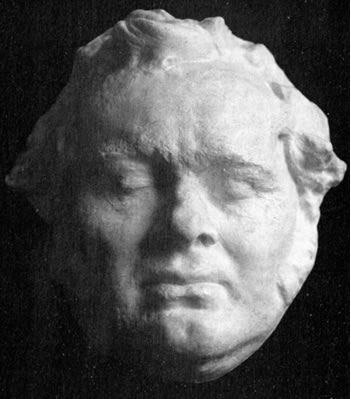
Mask image 1: just some image off the internet. I have no idea of its ultimate source.
As a test for possible distortions in the three images of the Schubert mask that we have let us scale them to the same outer dimension (with aspect ratio locked) and overlay them.
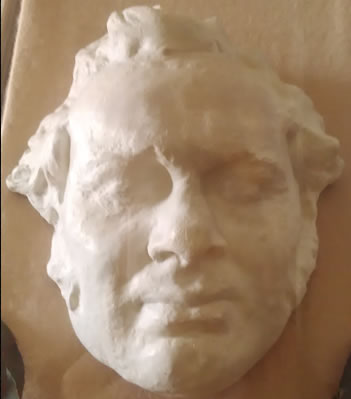
Mask image 2: a photograph taken on a smartphone camera of a commercial reproduction of the mask. The short focal length has produced a noticeable fish-eye effect, which has enlarged the nose and reduced the back of the head. This is the reason that portrait photographers often use lenses with long focal length.
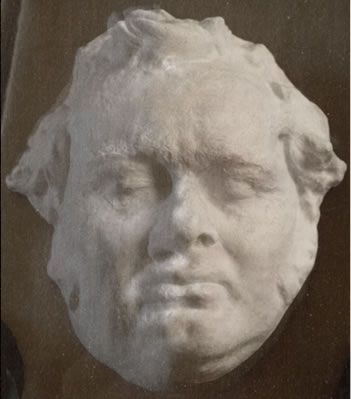
Mask image 1 + 2 superimposed. Allowing for the fact that this image is taken from a slightly lower angle than that of image 1, the overlay shows no appreciable aspect differences apart from the lens distortion.
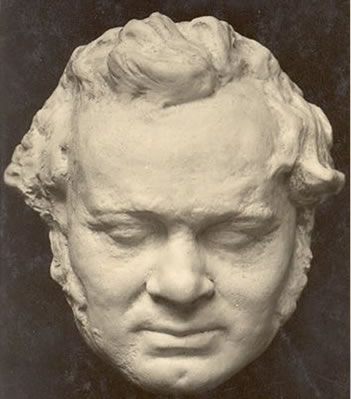
Mask image 3: an image from a printed postcard. In terms of detail and clarity this is by far the best image we have available, unfortunately the downward facing pose will affect vertical measurements. In the analysis we have occasionally used this photograph as a guide for locating our width measurement points.
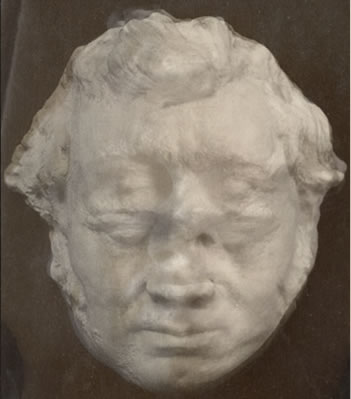
Mask image 1 + 2 + 3 superimposed. Allowing for the fact that this image is taken from a higher angle than that of image 1 or 2, the overlay shows no appreciable aspect differences.
Facial measurements
Let us now take the two images and mark on them the positions of various facial features.
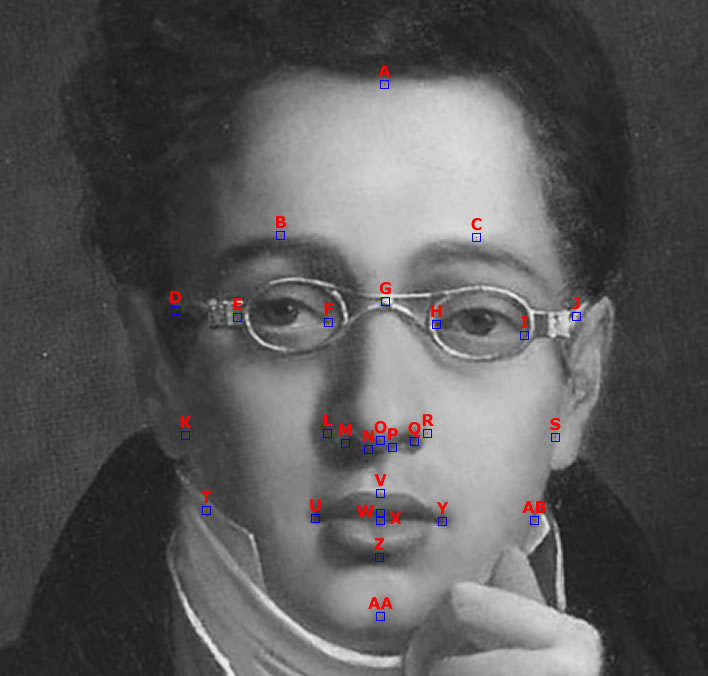
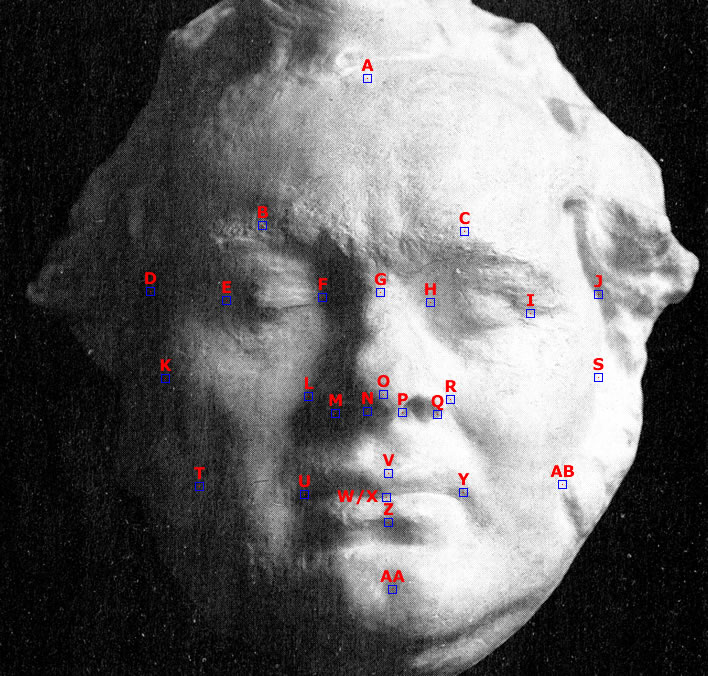
The measurement points are marked by a single red pixel, enclosed in a blue square to assist seeing it.
The fact that we are working with the positions of single pixels should not mislead us into overstating the accuracy of the location of the point on the face. It would be possible to move most of the pixels around to some extent and still have them in reasonable locations. There may even be cases where the reader looks at the position of a pixel and thinks it to be inaccurate.
However, although of course we would always like as much accuracy as possible, we can be fairly relaxed about small errors because none of the conclusions will depend on small differences that might be affected by a slightly inaccurately positioned pixel. Small differences will be noted but ignored and no conclusion of the analysis will depend on them.
Distances (D) are calculated between the measurement points on the portrait (P) [Dp = (P2–P1)] and on the mask (M) [Dm = (M2–M1)]. Therefore, in the following tables, positive numerical and percentage differences mean that the respective distance is greater in the mask than in the portrait; conversely, negative differences mean that the respective distance in the mask is smaller than that in portrait.
The scaling factor
In order to compare the two distances we originally introduced a scaling factor (SF), which would make comparisons independent of the sizes of the respective images. The factors were derived from the ratio of pairs of easily identifiable points, preferably with as great a separation as possible between them.
This scaling factor proved to be unnecessary in practice, since the two images were fortuitously identically scaled (some calculated factors: 1.0592, 1.0411, 0.9441, 1.1079). Since all the calculated factors were well within the error range we decided to simply use SF=1 as the factor, though we left the title 'scaled' on the column of distance comparison: scaled = (Dm × SF) – Dp. Once again it must be stressed that the final analysis does not rely on any slight differences between measurements: the tiny variations in the scale factor have no significance at all.
Of particular importance is the percentage difference in the last column. A large numerical difference has less and less meaning the larger the original distances are. Given the many potential sources of measurement inaccuracies we generally ignore a percentage difference smaller than 10.
The measurement points on the human face fall into two natural orientations, horizontal and vertical. For clarity and ease of viewing we have dealt with these separately.
Horizontal measures
The marker points for horizontal measurements cluster in the three principal sections of the human face: the eyes, the nose and the mouth. NB: 'right' and 'left' here relate to the sitter's right/left, not the viewer's right/left.
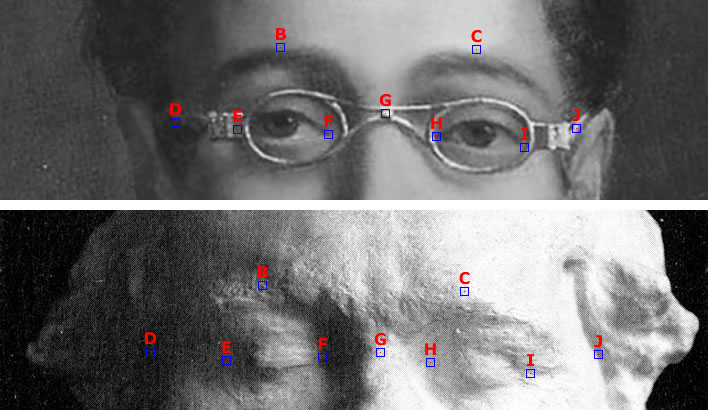
| Eye section | Path | Portrait | Mask | Scaled | Percent |
| H01– Eyebrow centres | B-C | 196 | 202 | 6.00 | 3 |
| H02– Width of head at eye-level | D-J | 401 | 448 | 47.00 | 12 |
| H03– Eyecorners outer | E-I | 287 | 304 | 17.00 | 6 |
| H04– Eyecorners inner | F-H | 108 | 108 | 0.00 | 0 |
| H05– Eyecorner R to bridge of nose | E-G | 148 | 154 | 6.00 | 4 |
| H06– Bridge of nose to eyecorner L | G-J | 191 | 218 | 27.00 | 14 |
Some distance measurements differ only trivially between the two images: H01, H04, H05. These are measurements concerning the position of the eyebrows and the inner corners of the eye. The distance between the two outer corners of the eye (H03) is slightly larger on the mask, but given the uncertainty of the positioning on the mask and a percentage score lower than 10, nothing should be made of this difference. Two differences are notable, however: H02, the distance between the temples and H06, the distance between the bridge of the nose and the left eye corner.
These two measurement distances are the objective confirmation of the subjective perception of Schubert's broad head. It is clear that the subjective perception of width is reinforced by Schubert's luxuriant hair on the side of his head, but the face is also objectively broad.

| Nose section | Path | Portrait | Mask | Scaled | Percent |
| H07– Width of head at nose level | K-S | 370 | 433 | 63.00 | 17 |
| H08– Width of nose | L-R | 100 | 142 | 42.00 | 42 |
| H09– Outer nasal apertures | M-Q | 69 | 102 | 33.00 | 48 |
| H10– Width of nose R to centre | L-O | 53 | 75 | 22.00 | 42 |
| H11– Width of nose centre to L | O-R | 47 | 67 | 20.00 | 43 |
In the nose section, every width comparison reinforces the width of Schubert's face and in particular the width of his nose. The nose in the portrait is appreciably narrower. Because of the deep shadows in the photograph of the mask the value for the width of the head at the level of the nose, H07, has to be considered uncertain, which could also mean that the true value of an accurate measurement might even be larger, since it is difficult to see how this distance on the mask could be reduced.
The breadth of Schubert's nose was mentioned in Leopold Sonnleithner's reminiscences of him, who suggested it gave him a negroid look. [Erinn 141] Joseph von Spaun rejected this language, but did not dispute the size. [Erinn 416]
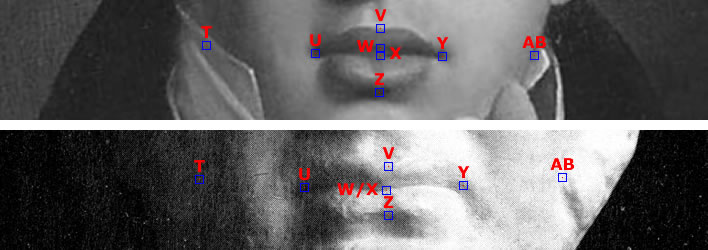
| Mouth section | Path | Portrait | Mask | Scaled | Percent |
| H12– Width of head at mouth level | T-AB | 328 | 363 | 35.00 | 11 |
| H13– Right cheek to right mouth corner | T-U | 109 | 105 | -4.00 | -4 |
| H14– Left mouth corner to left cheek | Y-AB | 92 | 99 | 7.00 | 8 |
| H15– Mouth corner width | U-Y | 127 | 159 | 32.00 | 25 |
The differences in the widths of the head and the widths of the mouth between the mask and the portrait are striking. They are the objective confirmation of the observer's subjective impressions of the width of Schubert's face and that of his mouth. In contrast, the lips of the sitter in the portrait are small, full and almost pouting. The artist has applied that old trick of the guild of portrait painters and painted the sitter's lips slightly apart, thus emphasising that delightful, kissable pout.
Given the breadth of Schubert's mouth, it is unsurprising that there are only slight differences in the distance between the corner of the lips and the outer cheeks since the width of Schubert's face at this point is substantially occupied by the broad mouth.
Vertical measures
The most useful grouping of the vertical measurements of on the facial images is according to the loci of the principal measurement points. The most identifiable features are the hairline, the eyebrows, the bridge and the tip of the nose, the edges of the top and bottoms of the lips and, of course, the chin dimple.
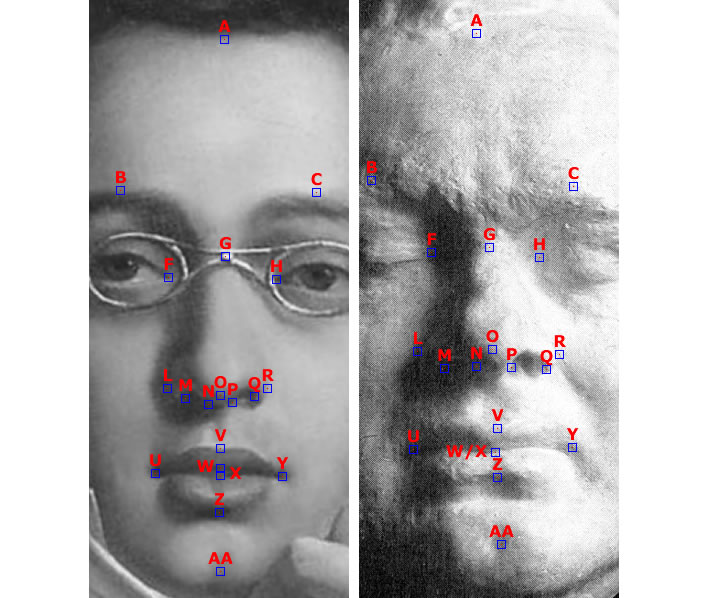
| Locus chin dimple | Path | Portrait | Mask | Scaled | Percent |
| V01– Hairline to chin dimple | A-AA | 532 | 511 | -21.00 | -4 |
| V02– Eyebrow right to chin dimple | B-AA | 381 | 364 | -17.00 | -4 |
| V03– Eyebrow left to chin dimple | C-AA | 379 | 358 | -21.00 | -6 |
| V04– Eyecorner R to chin dimple | F-AA | 294 | 292 | -2.00 | -1 |
| V05– Eyecorner L to chin dimple | H-AA | 292 | 287 | -5.00 | -2 |
The relative height of the two faces is difficult to define reliably – for most people the front hairline is a location that recedes through the years. However, Schubert was only thirty-one when he died, a fact which might make the measurement useful, if not totally reliable. The series of weakly negative values in this respect, whether from hairline, eyebrows or eye corners to the chin dimple are in line with the subjective perception of the squatness of the face in the mask compared with that in the portrait, although not significantly so.
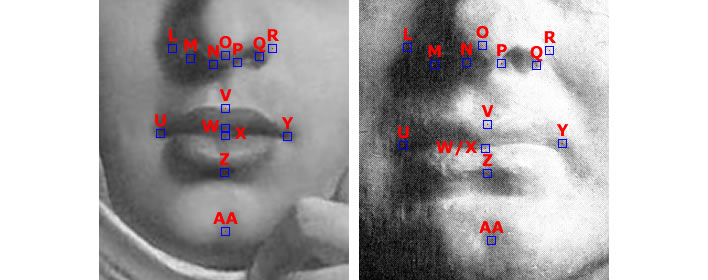
| Locus tip of nose | Path | Portrait | Mask | Scaled | Percent |
| V06– Tip of nose to chin dimple | O-AA | 176 | 195 | 19.00 | 11 |
| V07– Tip of nose to top of top lip | O-V | 53 | 79 | 26.00 | 49 |
| V08– Tip of nose to bottom of lower lip | O-Z | 117 | 128 | 11.00 | 9 |
The tip of the nose, the chin dimple and the top and bottom edges of the lips are relatively well-defined positions in both images. The much larger distances in the structures below the nose in the mask is both subjectively and objectively apparent – the distance between nose, mouth and chin are all appreciably greater in the mask.
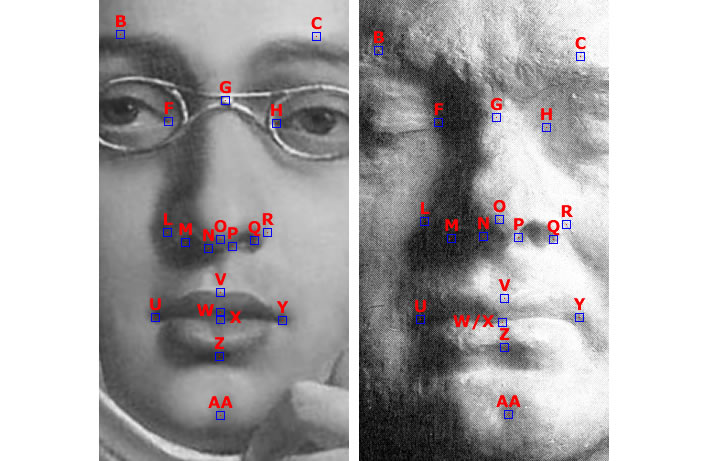
| Locus nose | Path | Portrait | Mask | Scaled | Percent |
| V09– Eyebrow right to tip of nose | B-O | 205 | 169 | -36.00 | -18 |
| V10– Eyebrow left to tip of nose | C-O | 203 | 163 | -40.00 | -20 |
| V11– Bridge of nose to tip of nose | G-O | 139 | 102 | -37.00 | -27 |
| V12– Bridge of nose to top of upper lip | G-V | 192 | 181 | -11.00 | -6 |
| V13– Bridge of nose to chin dimple | G-AA | 315 | 297 | -18.00 | -6 |
As we have seen, the overall length of the face in the mask and that in the portrait are not very different. Given that the area below the nose is appreciably larger in the mask, something has to give – the length of the nose. The nose in the mask is substantially shorter than that in the portrait. We thus find in the mask the characteristic and defining feature of Schubert's face: the wide but short nose.
Conclusions from the analysis
If we assume, therefore, that the mask is an authentic portrait of Schubert late in life or even in death, we find it impossible to reconcile this image with the face we see in the portrait of the youthful Schubert.
Many facial features may change with age, but noses do not shrink, mouths do not move around the face, oval faces do not become square, lips do not change from pouty ovals to grim slits. We are not talking about the depredations of age here: in the company of the many horrible death-masks of the shrunken and toothless decrepits from that era, Schubert's mask stands out as youthful, forceful, vigorous almost.
The distance in time between the supposed date of the painted portrait and the assumed date of the mask is around fourteen years. Even allowing for an exclusive diet of acidic heurigen wine, cheap punch, beer and unidentified sausage products during that time, none of the differences we have highlighted could possibly have taken place. Schubert's syphilis is also innocent of these major mutations.
Even if we allow for the undoubted fact that portrait painters do their best for their paying subjects – making them taller, smoothing their faces, extending the height of their foreheads (very important) – Schubert cannot be the subject in this portrait. Our numerical analysis has only served to confirm the evidence of our unaided eyes.
Contemporary descriptions
At the risk of putting even sturdy readers in an induced coma, there is more to be said on this subject. Like all the worst memes, the belief that the subject of this portrait is Franz Schubert will not die quickly – as when attempting to kill a cockroach, one or two stamps are never enough, you have to keep going until you are sure the beast is dead. Not just flat, but dead.
Let us consider briefly how the people who knew him in the flesh described him. The most extensive description of his appearance was given by Leopold Sonnleithner in 1858. The full painting is repeated here so that you can compare it easily with Sonnleithner's description of the composer's appearance. The photograph of the mask is repeated after the description, ditto ditto.

Schubert was shorter than average, had a round, fat face, a short neck, a not very high forehead and full brown, naturally curly hair. His back and shoulders were rounded, the arms and hands pudgy with stubby fingers. The eyes, when I am not mistaken, were grey-blue. The eyebrows were bushy, the nose short and wide, the lips thick, the face slightly negroid. The skin was blondish rather than brunette, but with a tendency to develop small, darker coloured rashes. The head was set deep onto the shoulders and tilted forwards . Schubert always wore spectacles.
At rest the facial expression was more stupid than intelligent, morose rather than cheerful. One would have assumed that he was an Austrian or more possibly a Bavarian farmer.
Schubert war unter Mittelgröße, hatte ein rundes, dickes Gesicht, kurzen Hals, eine nicht hohe Stirn, volles braunes, sich natürlich kräuselndes Haar; Rücken und Schultern gerundet, Arme und Hände fleischig, kurze Finger, main potelée; das Auge (wenn ich nicht irre) graublau. Brauen buschig, Nase stumpf und breit, Lippen wulstig; das Gesicht etwas mohrenartig. Die Hautfarbe war mehr blond als brünett, aber zu kleinen Ausschlägen geneigt und hierdurch etwas dunkler. - Der Kopf saß etwas zwischen die Schultern gedrückt, mehr nach vorne geneigt. — Schubert trug immer Augengläser. Der Gesichtsausdruck schien in ruhigem Zustand eher stumpf als geistreich, eher mürrisch als heiter; man hätte ihn für einen österreichischen oder eher noch bayrischen Bauern halten können. [Erinn 141] Translation ©FoS.

After the publication of the biography, Joseph von Spaun took issue with its unflattering depiction of the physical Schubert.
These comments are very typical of Spaun, revealing the best and the worst in his character. He was intensely loyal and protective of Schubert's reputation. He displays good, calm judgement, but that of a civil servant writing a careful assessment for his masters. His instinct is to suppress the disagreeable and modulate the unpleasant into harmlessness. He will have nothing to do with the prurient things that so interest the rest of us.
The dangers of his opinions lie in that which he leaves out. Here is Spaun's modulation of the depiction of Schubert's appearance in the first published biography of Schubert by Heinrich Kreißle von Hellborn (1865):
Schubert has never been properly represented, either in appearance or character. His face is reproduced as almost ugly, negroid, an appearance to which anyone who knew him would object. The portrait painted and etched by Rieder is an extremely good likeness. Just a glance at it will tell you whether the face was ugly and negroid.
On the other hand, one cannot say that Schubert was handsome. He was, however, well-formed and when he spoke with friendship or smiled, his facial features were full of charm. When he worked, filled with enthusiasm and glowing with zeal, his features became exalted and almost beautiful.
As far as his body is concerned, after reading the biography one would imagine him to have been a fat lump. This is completely wrong. Schubert had a solid, squat body, but of fat or of a pot-belly there was no trace. His younger friend Moritz von Schwind exceeded him in circumference even then.
Schubert ist weder in körperlicher noch in geistiger Beziehung richtig bezeichnet. Sein Gesicht wird als ein beinahe häßliches, negerartiges geschildert; wer ihn aber nur immer kannte, muß dem widersprechen. Das von Rieder gemalte und in Kupfer gestochene Porträt Schuberts ist außerordentlich ähnlich. Man besehe es und urteile, ob das Gesicht ein häßliches, negerartiges sei. Man kann ebensowenig sagen, daß Schubert schön gewesen; allein er war wohlgebildet, und wenn er freundlich sprach oder lächelte, so waren seine Gesichtszüge voll Anmut, und wenn er voll Begeisterung, glühend vor Eifer arbeitete, so erschienen seine Züge gehoben und nahezu schön. Was seinen Körper betrifft, so dürfte man sich ihn, nach den Schilderungen in der Biographie, als einen Fettklumpen vorstellen. Das ist nun durchaus unrichtig. Schubert war festen, gedrungenen Körpers, aber von Fette oder einem Schmerbauche war keine Rede. Sein sehr jugendlicher Freund Moritz Schwind übertraf ihn schon damals am Umfange. [Erinn 416] Translation ©FoS.
We discussed Rieder's portrait of Schubert in our piece on Schubert's appearance. Both Sonnleithner and Spaun find it the most representative portrait of the composer, but then go on to contradict that representation directly in their own accounts
Spaun's magisterial balancing acts are interesting but are ultimately noble obfuscation in the service of the memory of his friend. The remark that Moritz von Schwind was even fatter than Schubert is a classic example of misdirection. Finally, the assertion that Schubert was not fat, merely stocky, is contradicted by an image we have from 1818, containing a fine caricature by Leopold Kupelwieser of the portly 21 year-old with a pronounced pot belly:
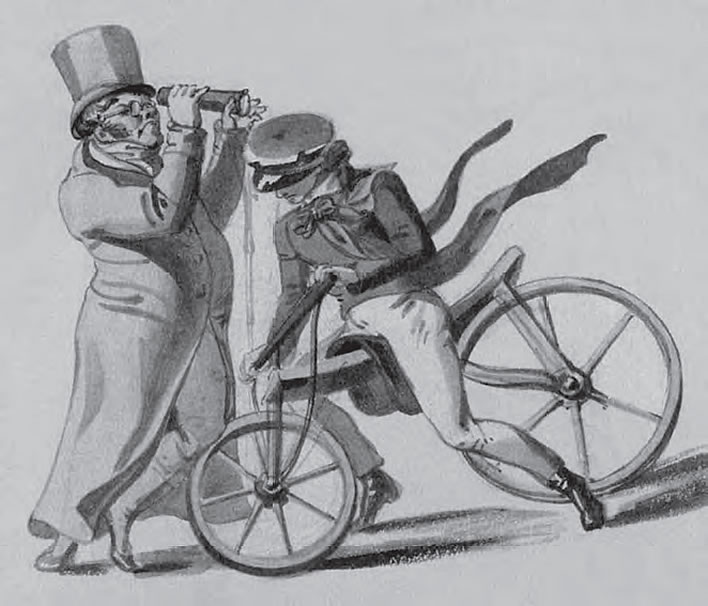
Das Kaleidoskop und die Draisine (The Kaleidoscope and the Draisine), 16 July 1818. Watercolor by Leopold Kupelwieser (Damian Klex).Image: Taken from [Steblin_2 9]
Thirty years after Schubert's death we can reasonably assume that Sonnleithner's memory may have let him down here and there, but not so far that he would entirely reinvent Schubert's appearance. His comments give us the impression of authenticity. They correspond in not a single respect with the supposed portrait of Schubert under consideration.
If not Schubert, who then?
Another of Rita Steblin's greatest hits in Schubert scholarship – one of her very greatest, in fact – was her discovery of the existence of the Unsinnsgesellschaft, the 'Nonsense Society'.
Despite the oppressive political climate of Austria (and particularly Vienna, of course) under Emperor Franz II/I's belljar, an informal group of young people, mainly artists of some sort, came together in the year and a half between April 1817 and December 1818. Franz Schubert was a leading member of the club. The group not only met in person, it produced numerous watercolour paintings and pages of handwritten text.
A few months after the discovery of the first documents at the beginning of 1994 Steblin unearthed the manuscripts of a set of newsletters collected together as the Archiv des menschlichen Unsinns, the 'Archive of Human Nonsense'. The handwritten newsletters were seemingly published each week – in other words, during its brief existence the society was very active.
The contents of the documents were totally apolitical; the identities of the participants hidden behind aliases. Had the police discovered the existence of the society and its proceedings and newsletters it would have been obvious to anyone that the society consisted of silly young people with time on their hands and apparently without a political thought in their heads.
The identities behind the aliases would have been discovered quickly. Since every member knew to whom the aliases referred, the police would have only had to find the weakest link and apply some pressure in order to discover who all these people were. Even if there was no obvious political content, the many obscene illustrations and double entendres would have got its members into trouble with the moral bigots in the paranoid authorities.
Readers who wonder about the reality of that risk should consider that, in the known archival remains from that time, the Nonsense Society is almost never mentioned. Those who participated in it or who knew of it never alluded to it in letters except in the most oblique fashion and would have been extremely discreet in speaking about it in public places. Even among the intimacies in the revealing letters between Schubert and his relatives and friends written while Schubert was in Zseliz, exactly during that period of Nonsense Society's existence, there is not a word, not a hint of the society.
Like a website on the modern 'dark web', it left no trace in the public world – it was 'under the radar' as we would say nowadays.
That is the reason that around 175 years went by without any Schubert scholar noticing this goldmine of material, until the attentive Rita Steblin unearthed it and realised its importance. The survival of the material we have, estimated to be about one third of the total, is in itself a surprise, given the risk in keeping such materials.
Rita Steblin has rightly invested much time and effort over the years in the decipherment of this treasure, which has brought Schubert's youthful life into much sharper focus. A discussion of her discoveries and decipherments is well beyond the scope of our task in the present article. Our current concern is the figure masquerading under the alias 'Aaron Bleistift'. Here he is, the figure on the left:
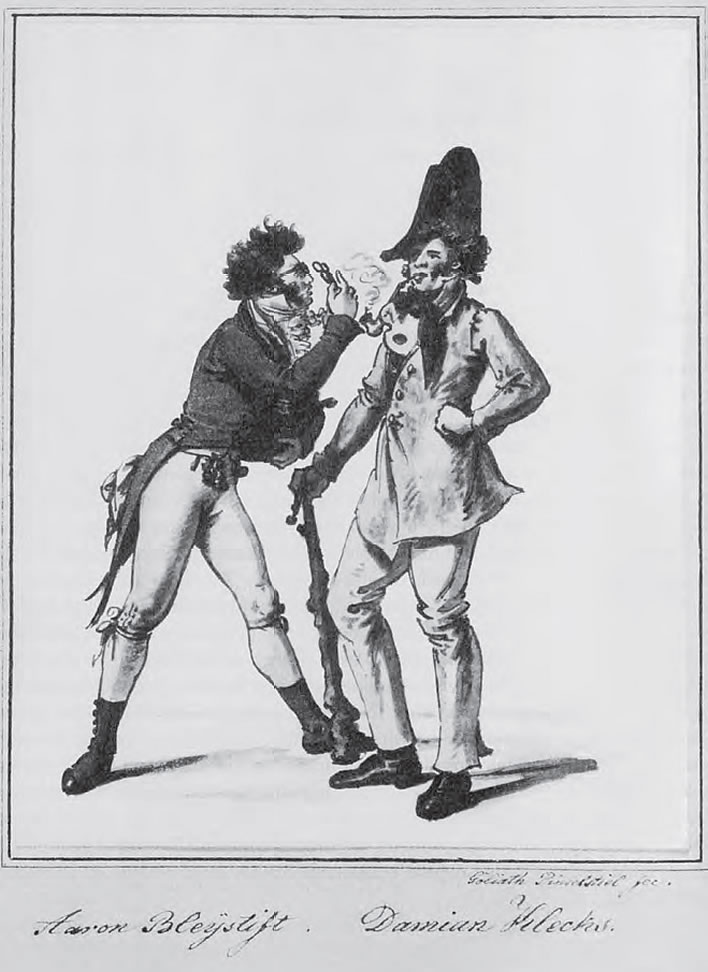
Play with Double Glasses. Carl Zimmermann and Leopold Kupelwieser, 31 December 1817. Watercolor by August Kloeber (Goliath Pinselstiel). Image: Taken from Rita Steblin, Schubert: The Nonsense Society Revisited, p. 24.
Alarm bells will be ringing in our attentive readers' heads. The lefthand figure in the knee tights, the bundle of Petschaften hanging at the right hip, the cutaway coat, the spectacles and the rather wild, sticking-up hair. Who does that remind you of?
The titles under the figures give the aliases Aaron Bleistift and Damian Klecks. The former was the alias of the Prussian artist, Carl Friedrich Zimmermann (1796-1820), the latter that of Leopold Kupelwieser (1796-1862).
The similarities did not escape the notice of Rita Steblin, either, who, looking at the caricature, recalled the portrait in which the subject is
seated at a fortepiano, with a number of signet rings at his waist … The dress, the glasses, the hair reproduce the Abel portrait with stunning accuracy.
[Steblin_2 25]
Well, there is no arguing with that, but then Steblin makes a strange connection. Believing that the subject of the portrait painting is indubitably Schubert himself, she now has the problem that this figure is also indubitably labelled as a representation of Aaron Bleistift – that is, Carl Friedrich Zimmermann.
Schubert's principal alias was some variant of Ritter Juan de la Cimbala ('Don Giovanni of the Keyboard') [Steblin_2 14]. If this drawing is a caricature of Schubert (as he appears in the portrait), why is it mislabelled? Why isn't it simply titled Ritter Juan de la Cimbala? Taken at face value, Steblin's research has just uncovered the identity of the subject in the painting: Aaron Bleistift, a.k.a. Carl Friedrich Zimmermann.
Unfortunately, Steblin is trapped by the misattribution of the subject of the portrait painting as Franz Schubert. This means the figure labelled Aaron Bleistift must therefore be Schubert. The only explanation she can find for this is that Zimmermann has dressed like him (or August Kloeber, Goliath Pinselstiel, Zimmermann's friend, who drew the caricature, has dressed Zimmermann like him) as a sort of parody of Schubert.
Even on the surface it is quite difficult to take this sticking-plaster solution seriously, despite its ingenuity. If, however, we have cleared our minds of all thoughts that the portrait shows Schubert, then all these mental gymnastics are unnecessary and we have no difficulty taking the label on the caricature at its face value. When we do, we come to the conclusion that both the caricature and the portrait are representations of Carl Friedrich Zimmermann.
Not only that: in the portrait the subject has a pencil in front of him. This is the perfect indicator that the subject is the person called Aaron Bleistift 'Aaron Pencil'. Zimmermanns real surname means 'carpenter' in German, a trade associated with the pencil.
If this is the case, though, then why is Zimmermann sitting at a keyboard? At the moment, I have really no idea at all. If I wanted to be mischievous I might suggest that perhaps doing that was the real attempt to parody Schubert, but, as far as I know, Schubert rarely composed at the piano – he often didn't have one available. I might also point out that Zimmermann went on to marry the pianist Johanna Riess in Berlin. Does this fact have anything to do with the presence of the piano? No idea.
Furthermore, since Schubert was a good pianist, but not a virtuoso, sitting him at a piano would have been really rather inappropriate. None of his other formal or semi-formal portraits place him at a piano – in a music-mad city full of quality pianists, that would be asking for trouble. He was a composer, whose work was done with pen and ink, sitting at a table.
In 2000 Rita Steblin published some further research that threw some light onto the then little-known figure of Carl Friedrich Zimmermann. He was a colourful figure who died much too young in a drowning accident in the river Loisach, near Wolfratshausen, about 40 km south of Munich. [Steblin_3 272f]
This is not the place to retail Steblin's work on Zimmermann in detail. Let's just have a look at a self-portrait he drew, probably in 1820 and possibly just a few months before his tragic death, which was intended for inclusion in 'Carl Christian Vogel von Vogelstein's collection of artists' self-portraits in Dresden', so Steblin tells us.
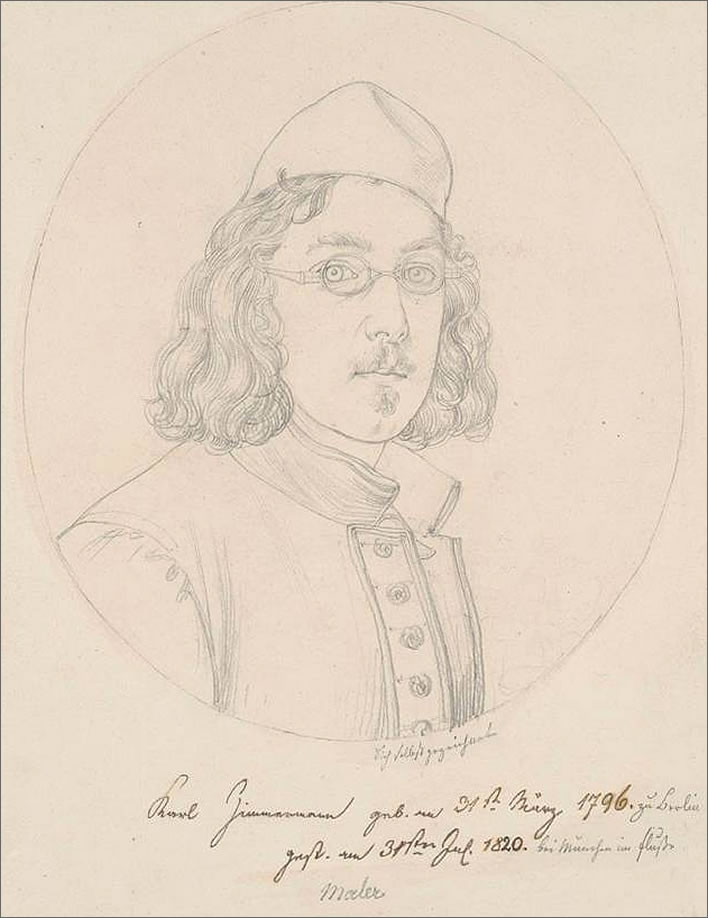
Bildnis Zimmermann, Karl (1793-1820), Maler, 1820. Image: Dresdner Kupferstich-Kabinett.
Here we see Zimmermann in a portrait of impeccable dating, attribution and provenance wearing the same sort of spectacles we saw in the 'Schubert portrait'. The face is narrow and elongated, the hair long and wavy (but not curly), the eyebrows rounded and well formed, the mouth small, with full lips and – would you believe it? – the eyes are accurately portrayed as asymmetric – the right eye inclined to the right.
Zimmermann, bless him, has not improved his appearance but rendered his defects faithfully. In modern English the defect is rather confusingly called a 'squint', but in the much more precise dialect of my childhood it was called 'skenning'. In primary school we learned the old term 'wall-eye' for an eye swivelled askew and in class happily sang of the 'wall-eyed cook' who 'had a cock-eyed look', a woman 'With her one eye on the pot and the other up the chimney, / With a bow wow wow, fa la the dow-a-diddy, bow wow wow.'
This disconcerting burst of jollity from your usually grumpy author, reader, arises from the fact that Professor Dr Elmar Worgull – remember him, all those paragraphs ago? – made great play of the leicht asymmetrische Blick, the 'lightly asymmetric gaze' of the subject in the portrait as being indicative that the portrait was definitively that of Schubert.
I shall spare you Worgull's half-page of convoluted and circular reasoning [Worgull 66f] in which he notes that, despite the fact that such skenning appears in no other Schubert portraits apart from one done by Leopold Kupelwieser, this skenning 'strengthens the assumption that it [in Kupelwieser's portrait and in the 'Abel' portrait] is a real representation of a physical phenomenon occurring in one and the same person'. In Worgull-Deutsch: bestärkt die Annahme, daß es sich jeweils um die naturhafte Abbildung ein und derselben Person handelt [Worgull 67], to which your author can only say: '"O frabjous day! Callooh! Callay!" / He chortled in his joy.'
I suppose at this point I could do another measurement comparison between the Zimmermann and the 'Schubert' portraits, but after the fifth stamp on the cockroach your foot starts to hurt and you know that the beast will get up and crawl on anyway. Let's reduce it to a simple question:
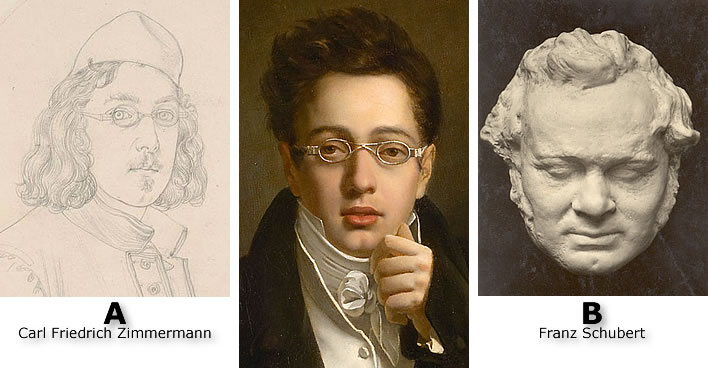
Who is more likely to have been the subject of the portrait painting in the centre, Carl Friedrich Zimmermann (A) or Franz Schubert (B)?
The Jewish question
Carl Friedrich Zimmermann was a Prussian Jew. We don't know whether he was still a Jew in terms of some degree of religious observance, or whether he had converted to some flavour of Christianity. Shortly before his death, according to Steblin, he married the talented pianist Johanna Riess, another Prussian Jew from Königsberg who had converted to Protestantism. [Stablin_3 285]
This conversion business is not so simple, since antisemitism is not really about religion. Heinrich Heine converted to Protestantism, but would regret it later. The motto of the time seemed to be: once a Jew, always a Jew – his conversion to Christianity brought him no alleviation of the antisemitic animus towards him.
Carl Zimmermann's Jewish origins were gently mocked in the materials we have from the Nonsense Society. This was no specially antisemitic mockery, it is fair to say that everyone was mocked for everything in that group.
As we have seen, Carl's alias had the first name Aaron. Although the Nonsense Society materials are packed with complex allusions to internal and external people and objects – as Steblin demonstrated convincingly – they are not deeply conceived works of literature.
Your author's opinion is that there is no mileage in trying to elucidate some deeper meaning from the specific use of the name Aaron. It seems more likely that the name is just a generic allusion to Jewishness, in a context where many of the major Old Testament names such as Jacob had already been appropriated for Christian children, particularly within Calvinist and Pietist families.
In the society's materials, the fact that Carl Zimmermann, a.k.a. Aaron Bleistift is a Jew is referred to often: Steblin mentions common formulations such as our 'Hebrew' and our/the 'Israelite' and Aaron, hebraeisch gelaunt, 'Aaron, in Hebrew mood' [Steblin_3 275]; we also read that Bleistifts jüdischer Mund entlockte dem krummen Signalhorne machtige Töne, welche Ohr und Gefühl der Anwesenden gewaltig berührten , 'Bleistift's Jewish mouth enticed mighty tones from the curved signal horn, deeply moving the ears and feelings of those present'. [Steblin_3 279]
Franz Schubert: Solomonic judgement
So Franz Schubert was a Jew, then. Oh, just a minute … it's not Franz Schubert in that painting, is it? I forgot. We have to keep telling ourselves that this is not a portrait of Franz Schubert but probably one of Carl Zimmermann, who was in fact a Jew.
Apparently this racial attribution was frequently heard from a number of Austrians who saw the painting, Rita Steblin tells us [Steblin_3 267]. She, a daughter of the Canadian Enlightenment, puts it down to something, some particular je ne sais quoi in the Austrian air, or perhaps the water.
She concludes with an anecdote from a Jewish-American musicologist, who suggested that the attribution comes from the spectacles, which make the sitter look intellectual and, as we all know, intellectuals are Jewish.
To which we have to ask why the same spectacles on Schubert never made him look Jewish or intellectual. Well you can perch a pair of spectacles on the squat nose of the tubby grandson of Moravian-Silesian peasants but he still won't look intellectual, or Jewish, for that matter. See Sonnleithner's remarks above.
The subject of the portrait is Jewish. This came into my mind the first time I saw the picture and has been there ever since. As a keen observer of stereotypes, my track record in these matters is impeccable: I identified at first sight and without any hesitation Vladimir Putin as Slavic, Xi Jinping as Chinese, Shinzo Abe as Japanese, Narendra Modi as Indian and the broad nordic heads among the Scandinavian royals families as indisputably nordic. The subject of this painting is Jewish, without a doubt.
Pressed for one identifying characteristic, I have to say that there isn't one, except perhaps for the eyes, those dark brown, slightly hooded eyes, exuding, as one of my correspondents called it, 'the sentimental gaze'. Racial recognition doesn't work with checklists – it is far too subtle for that. Recognising race in itself is not a bad thing – facial recognition is after all what the human brain is best at – the moral dimension of such things depends what you do with that information.
Your author had considered making the argument that what one might call the perceptible 'Jewishness' of the portrait was in fact no accident but yet another feature of Nonsense Society high jinks. But how could that ever be proved?
Some years ago, heading for Zurich, I caught the early Postauto from the mountain village where I lived to take me down to the railway station in the valley.
Vincenz, a farmer who was a near neighbour of ours, asked me: 'Where are you going, looking like a Jew?' Vincenz was over ninety, still helping out with the farming; he taught me the alpine trudge, the small steps that could conquer any hillside or mountain path and would get you anywhere in that terrain, albeit rather slowly. He was an open-minded man, friendly and helpful to us, his alien neighbours.
The question was so odd and unexpected that I must have just looked at him with bafflement. 'That Judenhut, (Jew's hat)', he added. What? My ancient, battered and crumpled homburg? The half-dozen other passengers and the driver were all laughing their heads off.
Vincenz died a short while after this, in a headfirst fall onto concrete from the dome of a tall agricultural silo. What he, the ninety-something was doing up there with a hammer in his hand no one knew, but he died an alpine farmer's death.
A few hours later on that same day I was in Zurich, waiting at a tram stop near Bahnhof Enge, an area with a high Jewish population. I knew the area well: many years before a not particularly observant Jew called Kahn, who ran an advertising agency, had rented a room to me for an office there. Whilst I was standing at the tram stop a Jew came up to me and addressed me in American English with that characteristic Jewish directness. If you don't know what Jewish directness is then ask any resident of Jerusalem or New York – or Zurich, for that matter.
'Where's the synagogue', he said, Just that. The synagogues of Zurich are not marked on town plans, or public transport maps. If you use Google Street View to wander around Zurich you will notice in some areas that numerous buildings and frontages are blurred-out, frequently synagogues or Jewish businesses. Some will mysteriously not even appear, the photo jumping suddenly from one aspect to another. Knowing the area well I happened to know where the synagogue was – it was not far away, up the side street, the building with the armed guard. That is the state we are in today.
I gave the American the directions he needed and he just set off – no thank-you, no goodbye. Jerusalem, New York or Zurich. Why did he choose me to ask? I wondered. There were other people standing around, people whom he walked past. Then I remembered Vincenz's joke from that morning and the amusement of the other passengers. There I was, hat, beard (slightly rabbinical on that day, admittedly, not my usual Spitzbart) wearing a dark, flowing raincoat that Shylock might have recognised as his 'Jewish gaberdine'.
I felt a sudden sense of quite unjustified belonging and understood the cameraderie implied by the American's direct address. Of the people standing there, on reflection it seems that I was the one he could implicitly trust with this sensitive question.
Yes, there is such a thing as racial recognition and, if we are honest, which we rarely are in these matters, it is used as serviceably within the tribe as between the tribes.
So the subject of the painting is a Jew, indisputably so, and I, when I put my hat and raincoat on, am an honorary Jew and I can tell you: 'It takes one to know one'. Oy vey!
Update 28.05.2019
Just for fun
Images of Schubert's head found on illustrated postcards in the Sammlung Prof. Dr. S Giesbrecht at the University of Osnabrück.
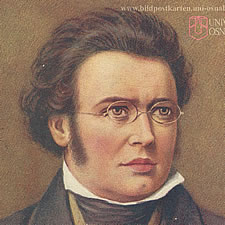
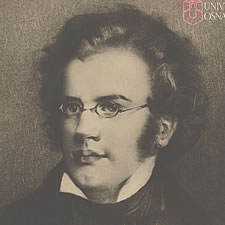
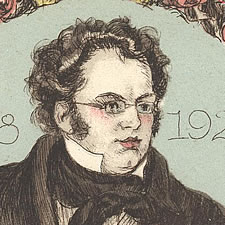
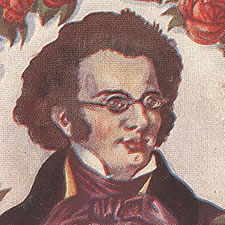
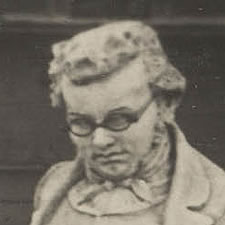
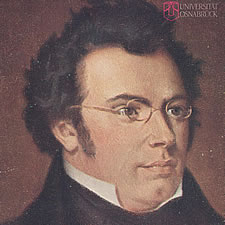
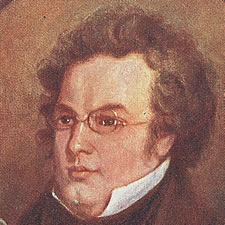
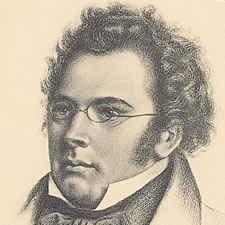
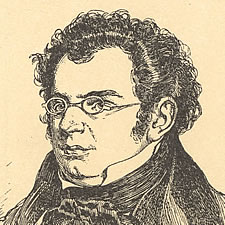
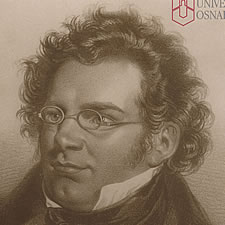
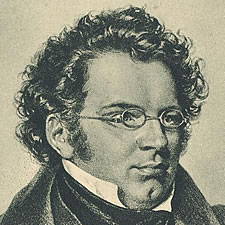
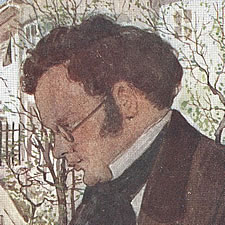
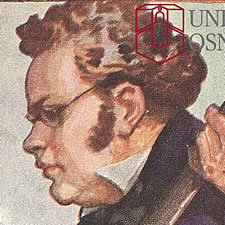
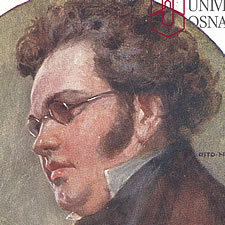
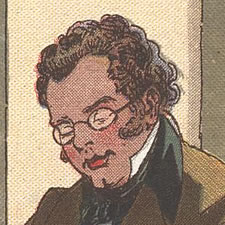
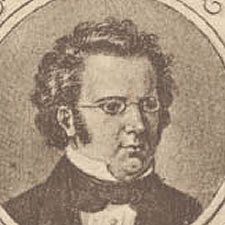
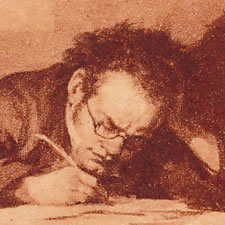
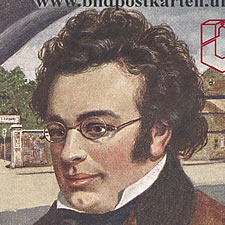
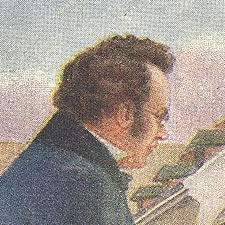
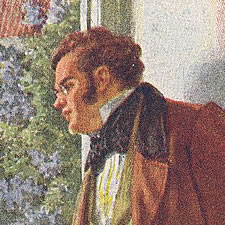
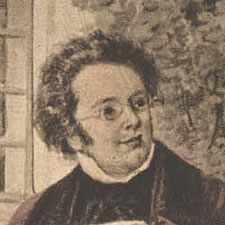
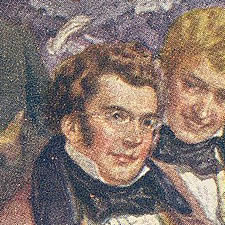
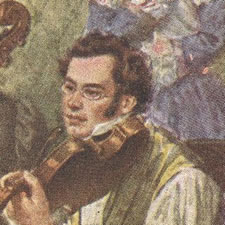
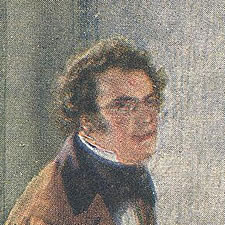
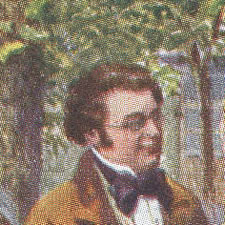
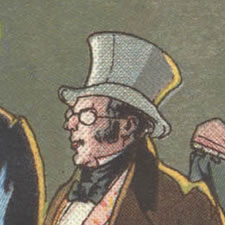
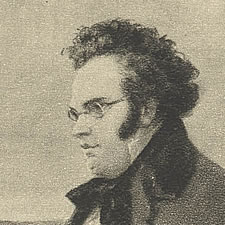
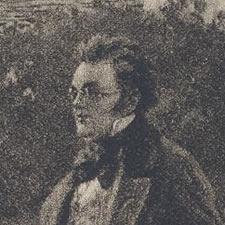
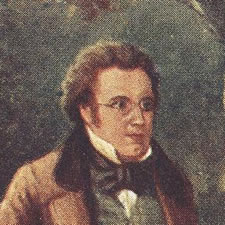
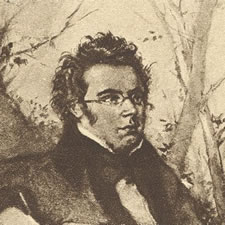
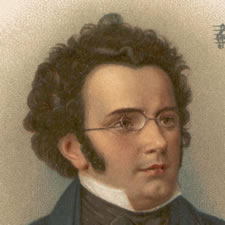
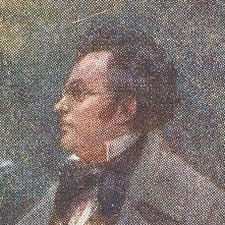
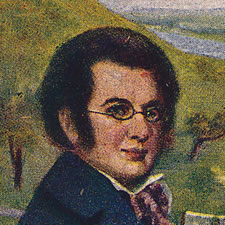
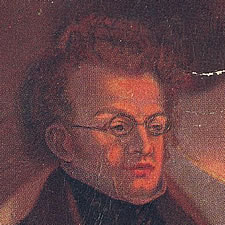
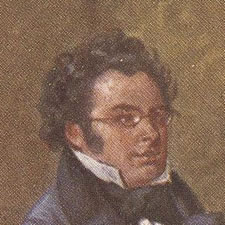
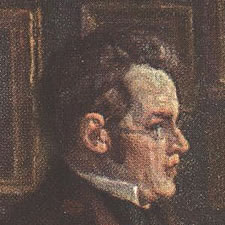
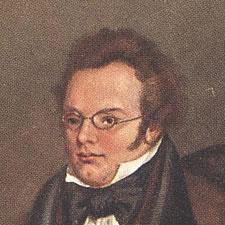
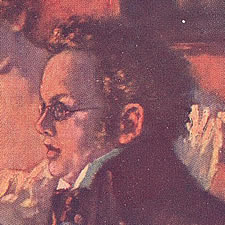
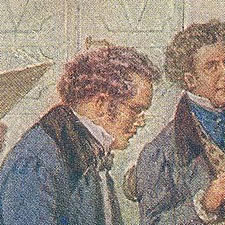
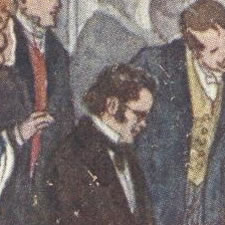
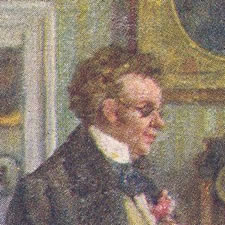
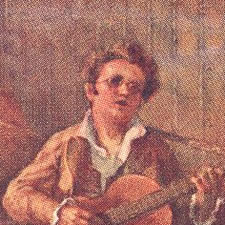
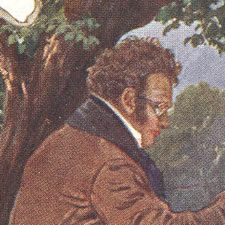
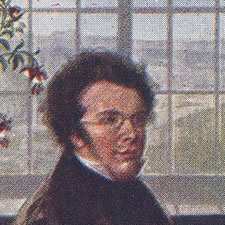
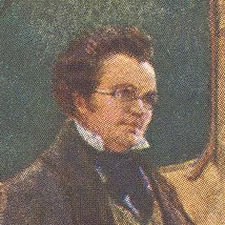

Sources
All sources are in German, unless otherwise noted. All translations ©FoS.
| Dok | Deutsch, Otto Erich, ed. Schubert: Die Dokumente Seines Lebens. Erw. Nachdruck der 2. Aufl. Wiesbaden: Breitkopf & Härtel, 1996. [DE] |
| Erinn | —, ed. Schubert: Die Erinnerungen Seiner Freunde. Wiesbaden: Breitkopf & Härtel, 1997. [DE] |
| Rosenthal | Rosenthal, Albi. 'Zum "Schubert-Porträt" von Abel', Schubert durch die Brille, January 1994, p. 90-91. [DE] |
| Steblin_1 | Steblin, Rita. Ein unbekanntes frühes Schubert-Porträt?, Tutzing: H. Schneider, 1992. [DE] |
| Steblin_2 | —, 'Schubert: The Nonsense Society Revisited' in Franz Schubert and his World, ed. Christopher H. Gibbs and Morten Solvik, , Princeton, 2014, p. 1-37. [EN] |
| Steblin_3 | —, 'Schubert's Hidden Past as Caricatured by the Unsinnsgesellschaft: The painter Carl Zimmermann and the Jewish Connection' in The Past in the Present, IMS Intercongressional Symposium, Budapest and Visegrad, August 2000, Volume 2, p. 263-286. [EN] |
| Worgull | Worgull, Elmar. 'Ein repräsentatives Jugendbildnis Schuberts', Schubert durch die Brille, January, 1994, p. 54-89. [DE] |
0 Comments UTC Loaded:
Input rules for comments: No HTML, no images. Comments can be nested to a depth of eight. Surround a long quotation with curly braces: {blockquote}. Well-formed URLs will be rendered as links automatically. Do not click on links unless you are confident that they are safe. You have been warned!